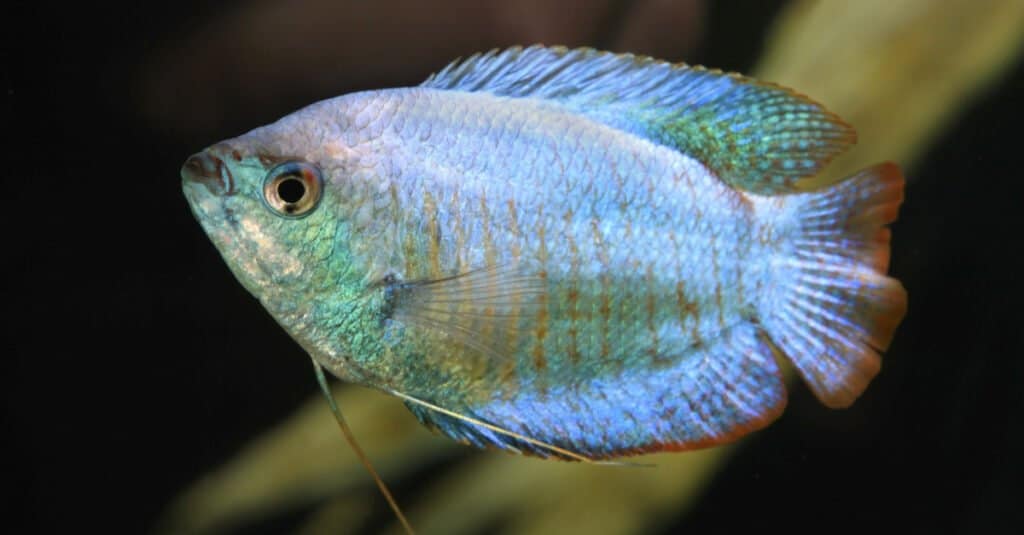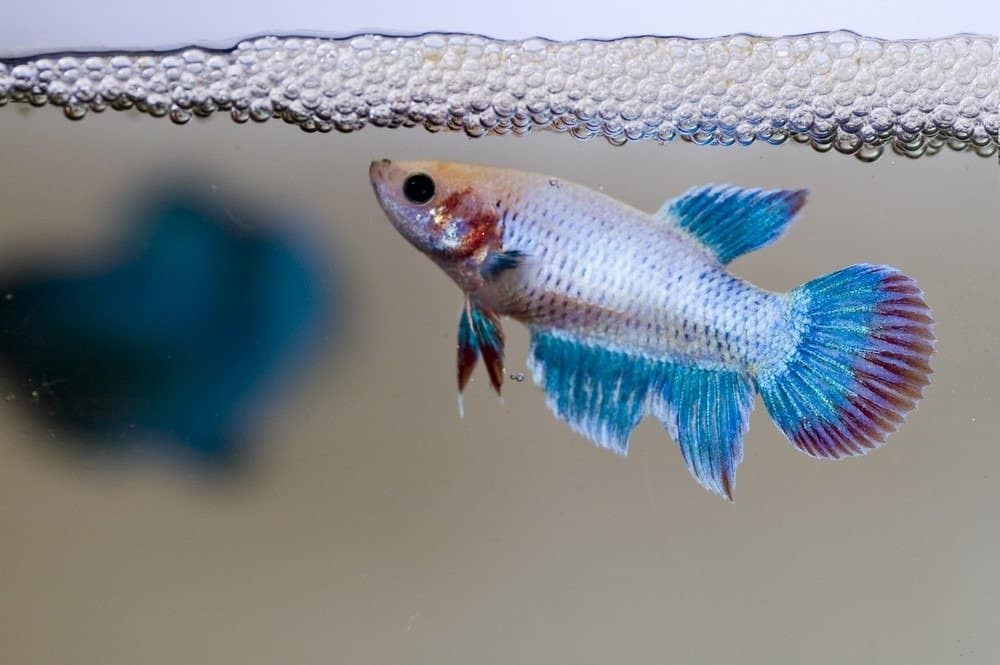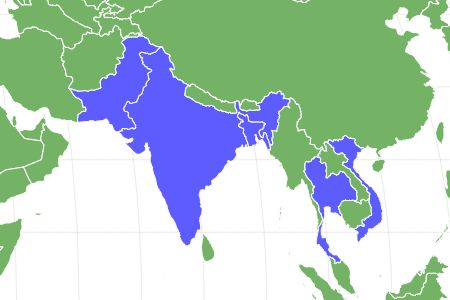Dwarf Gourami
Trichogaster lalius
Dwarf gourami can live for over four years with proper care.
Advertisement
Dwarf Gourami Scientific Classification
- Kingdom
- Animalia
- Phylum
- Chordata
- Class
- Actinopterygii
- Order
- Anabantiformes
- Family
- Osphronemidae
- Genus
- Trichogaster
- Scientific Name
- Trichogaster lalius
Read our Complete Guide to Classification of Animals.
Dwarf Gourami Conservation Status
Dwarf Gourami Facts
- Prey
- Small crustaceans and insects
- Name Of Young
- Fry
- Group Behavior
- Social
- Fun Fact
- Dwarf gourami can live for over four years with proper care.
- Other Name(s)
- Flame, Honey, Neon Blue gourami
- Average Spawn Size
- 80 to 100 eggs
- Diet
- Omnivore
- Lifestyle
- Diurnal
- Type
- Gourami
- Common Name
- Dwarf gourami
- Origin
- South Asia
- Number Of Species
- 1
- Location
- India, Bangladesh, Vietnam
Dwarf Gourami Physical Characteristics
- Skin Type
- Scales
View all of the Dwarf Gourami images!
Dwarf gourami (Trichogaster lalius) is a species of colorful freshwater fish. They inhabit the waters of Southern Asia and are often aquarium pets. These are small-sized fish, 2 to 5 inches, that are available in many color and pattern variations. Dwarf gouramis were first described by F. Hamilton in 1822, and live in places like Bangladesh, Vietnam, India, and Thailand.

The blue gourami makes a colorful and popular freshwater fish in aquariums, typically growing no larger than 5 inches in size.
©Steve Bower/Shutterstock.com
3 Facts About Dwarf Gourami
- The male dwarf gourami is much more colorful than females, with females having a duller appearance.
- Dwarf gourami are social fish that benefit from opposite-sex pairs or groups.
- Dwarf gourami are anabantoids. They can develop a labyrinth organ that allows them to breathe oxygen from the surface of the water. This allows them to survive in low-oxygen environments.
Dwarf Gourami Species
There are currently over 130 recognized species belonging to four sub-families and 15 genera of gourami in the Osphronemidae family. Dwarf gourami is one of these species, and the common name dwarf gourami itself only describes one species of fish.
Dwarf Gourami Classification and Scientific Name
Scientifically known as Trichogaster lalius, dwarf gourami belongs to the Anabantiformes order in the Trichogaster genus.
Dwarf Gourami Appearance

Dwarf gourami can be found in a variety of colors, but they all have thread-like ventral fins that look like whiskers.
©Bukhta Yurii/Shutterstock.com
These beautiful dwarf fish have a fascinating appearance that has made them a top choice for many tropical fish keepers. They are small, at around 2 to 5 inches in length, with males being slightly smaller than their female counterparts. Dwarf gouramis have a compressed and horizontal body that is framed by long dorsal and pelvic fins.
The female dwarf gourami typically has a more rounded belly and dorsal fin. Conversely, the males have a larger dorsal fin that ends at a point. One of the dwarf gourami’s most distinctive features is their long, threadlike unique ventral fins. These long ventral fins have touch-sensitive cells that allow the fish to gain sensory information from their surrounding environment. Dwarf gouramis rely on their ventral fins to navigate their environment and detect various objects.
In some cases, dwarf gourami may use their ventral fins to find food. And one ventral fin can sometimes be more independent than the other when moving. It’s also possible for these fins to give the dwarf gourami a better understanding of their environment. They can use these fins to judge distances between themselves and other fish or objects like plants, rocks, and substrate.
Another fascinating aspect of their appearance is their wide range of colors. The male dwarf gourami is much more colorful than the female. It has color variations such as blue, flame, honey, neon blue, red, and sunset. In the wild, the males have diagonal stripes along their bodies that are generally red or blue. Females are duller with a silverish-grey coloration. Due to all their color variations, they are sometimes labeled by their color rather than as dwarf gourami.
Dwarf Gourami Distribution, Population, and Habitat
Dwarf gourami is native to Bangladesh, India, and Pakistan in Southern Asia. They also reside outside their native range in the United States and Singapore. Here you will find them inhabiting the slow-moving waters with thick vegetation. The water is usually acidic and shallow, while murky with a muddy bottom. These water bodies include swamps, streams, rice fields, ponds, and lakes which have tropical conditions.
As an anabantid, dwarf gourami can develop a lung-like labyrinth organ. This allows them to gulp oxygen from the surface of the water. This organ allows dwarf gourami and other anabantids like betta fish to temporarily survive in less-than-ideal conditions.
The dwarf gourami is a popular fish as a food source and in the pet trade industry. This has allowed them to be a least concern according to the IUCN red list. This fish currently faces no threats to their population numbers.
Dwarf Gourami Predators and Prey
Dwarf gourami are omnivores both in the wild and in captivity. Their wild diet consists of insects, zooplankton, small crustaceans, and algae. Wild dwarf gouramis will prey on insects that land on the water’s surface, such as mosquitos and their larvae. Captive-bred dwarf gouramis are usually fed an omnivorous diet that consists of plant and animal matter in a pellet or flake form. When feeding your pet gourami, you should include live or freeze-dried foods like bloodworms or brine shrimp in their diets as a supplement.
While they are small predatory fish themselves, it’s unknown which predators dwarf gourami face in the wild. However, larger carnivorous fishes like cichlids can injure and kill dwarf gouramis in aquariums. This makes it important to choose compatible tank mates for your gourami to ensure they stay safe from other predatory fish.
Dwarf Gourami Reproduction and Lifespan
Most dwarf gourami live between three to five years, with an average lifespan of four years. However, several factors such as stress, poor water quality, disease, and improper living conditions can reduce a dwarf gourami’s overall lifespan.

Just like betta fish, dwarf gourami creates bubble nests at the surface of the water.
©mnoor/Shutterstock.com
Male dwarf gouramis will build a bubble nest to attract a potential mating partner, and it may indicate that they are ready to spawn. Once males find a reciprocating female, they engage in a spawning ritual. During this ritual, the male fertilizes around 80 to 100 eggs. The fish deposit these eggs into the bubble nest where the male guards them until they hatch.
Not all of these eggs are guaranteed to hatch, and there will be significantly fewer fry that hatch than eggs. The spawning ritual is fascinating and similar to other anabantids. The male and female dwarf gourami will swim in a spiral underneath the bubble nest, and the male will appear as if he is squeezing the female by wrapping his body around her to release the eggs.
Dwarf Gourami in Fishing and Cooking
In South Asian countries, dwarf gourami is a low-cost freshwater fish commonly eaten. They are a source of animal protein rich in essential nutrients for the lower class in South Asian countries. They are also small indigenous target fish for artisanal fishers. These fishers use traditional gear like drag-and-push nets, traps, or a hook and line to catch the dwarf gourami.
View all 110 animals that start with DDwarf Gourami FAQs (Frequently Asked Questions)
Where is dwarf gourami found?
Dwarf gouramis originate from the slow-moving and vegetation-rich waters in Southern Asia. Here they can be found in India, Bangladesh, and Thailand. However, you can also find dwarf gourami outside of their native range in Colombia, the United States of America, and Singapore. Dwarf gouramis prefer to inhabit slow-moving streams, rice fields, lakes, and canals that may become hypoxic.
What do dwarf gourami eat?
All dwarf gouramis are omnivores that eat a selection of both plant and animal-based matter as staple foods. In the wild, dwarf gourami prey on smaller crustaceans and insects, while captive-raised dwarf gourami eat pelleted or flake food. They also consume algae and various plant materials in their aquarium or wild habitat.
What size tank do dwarf gourami need?
When choosing a suitably sized tank for your dwarf gourami, you want to ensure it is large enough to support the number of fish, equipment, and decorations you want to place inside. A good starting size for two dwarf gouramis is 20 gallons, and you can increase the size of the aquarium if you plan to add more fish inside.
Thank you for reading! Have some feedback for us? Contact the AZ Animals editorial team.
Sources
- IUCN Red List , Available here: https://www.iucnredlist.org/species/166445/6210533
- Seriously Fish Database, Available here: https://www.seriouslyfish.com/species/trichogaster-lalius
- Research Gate, Available here: https://www.researchgate.net/publication/352508965_Growth_Condition_Maturity_and_Mortality_of_the_Dwarf_Gourami_Trichogaster_lalius_Hamilton_1822_in_a_Wetland_Ecosystem_Beel_Dakatia_Southwestern_Bangladesh
- Research Gate, Available here: https://www.researchgate.net/figure/Position-of-the-ventral-fins-in-intact-gourami-during-a-slow-swimms-and-in-stationary_fig1_261034643
















